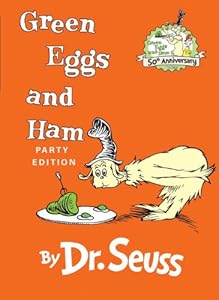 Cover via Amazon
Cover via AmazonBennett Cerf was the co-founder of Random House. As part of his duties as publisher, he also had an envious job -- he was Dr. Seuss' editor. And on March 12, 1957, Random House published Dr. Seuss' masterpiece, The Cat and the Hat. At 65 pages, the book is notable not only because of its well-deserved fame, but also because Dr. Seuss used only 225 unique words in writing it. Cerf was impressed -- so much so that he challenged Seuss to do one better. He wagered that Seuss could not author a book -- a meaningful one -- using fifty unique words or fewer. (click below to read more)
On August 12, 1960, Seuss won the bet. Random House published Green Eggs and Ham, 62 pages long -- and containing merely fifty different words. And of those fifty words, only one -- "anywhere" -- has more than one syllable or five letters.
The limited vocabulary did not make Green Eggs and Ham less popular. In fact, according to Publisher's Weekly, as of 2001, it was the fourth highest selling (in volume) children's book, ever. (The Cat and the Hat rings in at #9.)
What are the 50 words? This game, from the excellent website Sporcle, lets you guess.
Dr. Seuss's real name was Theodor Geisel. In 1925, as a Dartmouth College undergrad, Geisel -- then 21 years old -- and nine friends were caught, in his room, drinking gin. The problem? Prohibition. As part of his punishment, Geisel was not allowed to continue at the Lantern, Dartmouth’s humor magazine. A talented editorial cartoonist, Geisel did what many before him have done: donned a moniker, and participated under a pseudonym. In his case, under Geisel drew under the names L. Pasteur, L. Burbank, D. G. Rossetti, and one other -- his middle name, Seuss. It obviously stuck -- later with a made-up honorific.

No comments:
Post a Comment